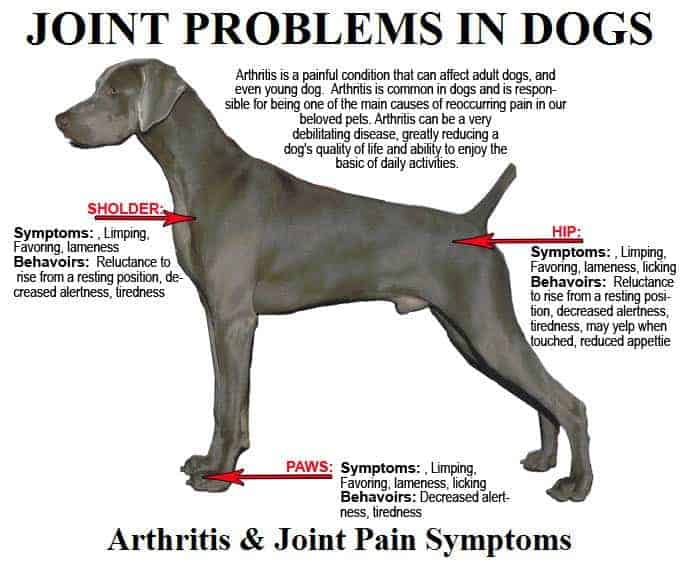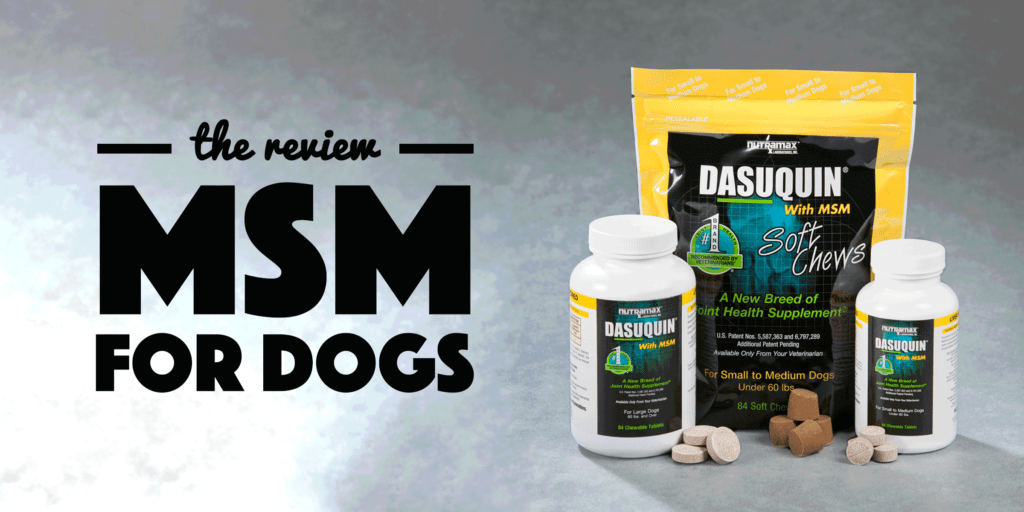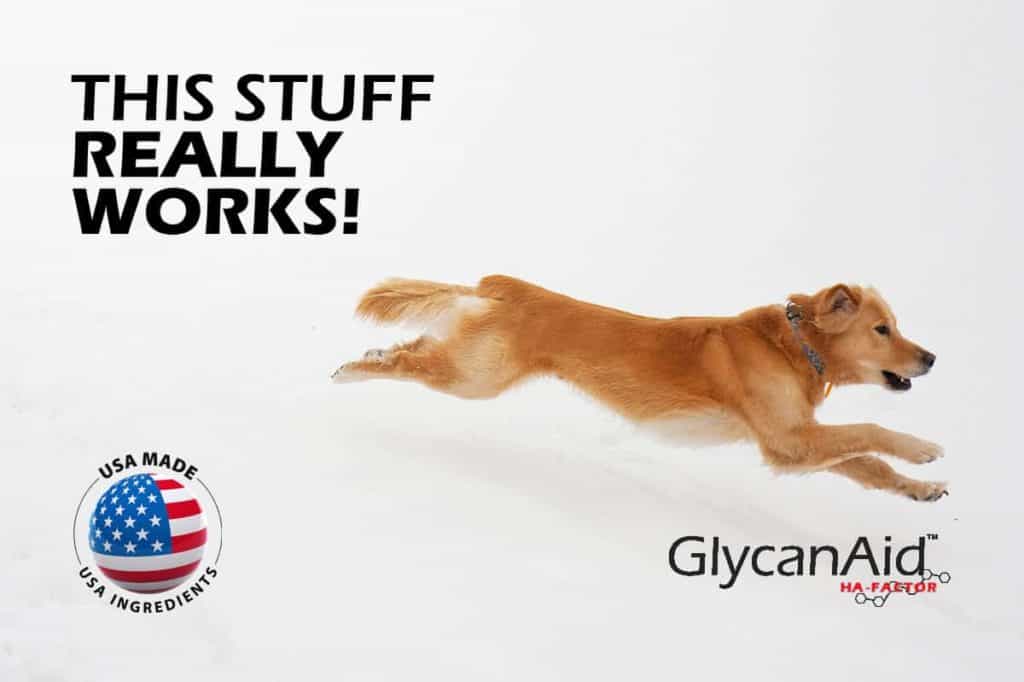Don’t you love it when your dog jumps on you for a welcoming lick? Or when he plays fetch with you? Dogs are very playful creatures, one reason we are fond of them. So it can really be disheartening for any pet parent to see a once-hyperactive and enthusiastic dog lose the bounce in his step.
Elderly dogs, in particular, are prone to limping, lameness, and swollen joints– all of which are signs and symptoms of degenerative joint disease or arthritis. According to the Arthritis Foundation, 1 out of 5 adult dogs has arthritis. Fortunately, there are many things that we can do to treat this chronic health condition.
What is Arthritis or Joint Problems in Dogs?
Arthritis is a medical condition characterized by inflammation of the joints resulting in pain and discomfort. It usually affects the joints of the hips, elbow, shoulder, knees, wrist, ankle, and backbone. This is considered a degenerative disease which means it usually worsens over time.
Arthritis is not a specific disease. It is often used as a catchall term for related joint pain and issues.
What Are The Types of Arthritis?
There are several types of arthritis or joint problem in dogs, the most common of which is osteoarthritis. Also called degenerative joint disease, it usually affects the joints of the elbow, stifle, and hips. It is said that up to 9 out of 10 dogs aged five years old and above have osteoarthritis.
Another type or form of canine arthritis is rheumatoid arthritis. While it is often confused with osteoarthritis, rheumatoid arthritis is different as it brought about by the canine’s immune system wreaking havoc on the canine’s joints. It is not clear as to why the immune system targets the joints, however. This form of arthritis is generally characterized by more severe stiffness and fever.
Septic arthritis, meanwhile, is brought about by a bacterial infection within a joint. It is caused by joint surgery or penetrating injury from a local area. It often affects a large joint, with its onset sudden and severely painful.
Aside from arthritis, there is also a joint disorder that can affect the mobility of dogs. One of these is hip dysplasia. A genetic development disorder, it stems from the misalignment of the hip joints causing the cartilage to deteriorate. Pain and inflammation soon follow.
Similar to hip dysplasia, elbow dysplasia is a genetic developmental disorder. In this condition, the bones fail to develop normally leading to joint misalignment and cartilage damage. It is also possible that bones will be chipped and this can lead to chronic pain and inflammation. Elbow dysplasia is common in large breed canines. Unfortunately, surgery is the only way to correct this condition.
It is not only large dog breeds who are genetically predisposed to the joint disorder. Even small breed toys are at risk of knee dysplasia, another type of joint issue characterized by malformed knee joints. Some dogs will have knee caps popping in and out of position, a condition called ‘luxating patella.’

What Causes Osteoarthritis in Dogs?
To be able to understand the cause of osteoarthritis in dogs fully, let’s get inside the canine joints. The typical joint has bone surfaces which are covered with a layer of smooth cartilage. A small amount of fluid lubricates the cartilage, enabling the surfaces to glide with minimal friction.
Canines with arthritis have damaged cartilage joints resulting in the bone surfaces rubbing against each other. This, in turn, causes discomfort and pain to the dog while further damaging the cartilage. It should be noted that cartilage gets a limited supply of blood, making it difficult for it to heal from arthritis.
Genetics is often identified as a significant contributing factor to osteoarthritis in dogs. Large breeds, for one, are more likely to suffer from osteoarthritis as they age while small dogs have higher risks of rheumatoid arthritis.
Just like in humans, age is a contributor to arthritis and joint disorder in dogs. As our pets age, the cartilages in their joints thin as well. This explains why the bones rub against each other resulting in breaking down.
There are other possible causes of joint pain in dogs such as previous injuries like an anterior cruciate ligament. Trauma after an accident and a sharp object penetrating a joint could also contribute to arthritis and joint problems. The repetitive motion of the affected area can potentially stress the joints and wear them out more quickly.
The same goes for obesity. There is clinical evidence that obese dogs have a higher risk of suffering from osteoarthritis compared to healthy dogs. There are many possible explanations for this. One is that overweight dogs will apply more vertical ground force on their limbs compared to lead dogs, with the increased strength translating to greater stress on the joints.
Also, obese dogs tend to have a greater range of motions in their joints, particularly in the hips, shoulders, and elbows. Combine that with the higher body mass, and you’ll have a dog requiring greater torque around the joints while in movement. This again adds more pressure and force on the joints which can fast-track the progression of arthritis.
What Are The Signs And Symptoms of Arthritis Problems?
There are numerous signs and symptoms of a dog suffering from degenerative joint disease. Dogs with arthritis are reluctant to jump, run, or be active. This is very much noticeable in elderly canines who used to play around when they were younger. For instance, your pet may no longer find playing fetch interesting at all. Or your dog may find it difficult to get into and out of your car. You may also see less of him going up and down the stairs.
Dogs with arthritis also look lame or stiff, especially after a long rest. At times, they may have difficulty rising from sleep or rest. Dogs with this painful condition would instead rest or sleep than go out for a walk because they can no longer bear the pain and discomfort. And during the occasions when they move around, dogs would tend to favor a leg because of the pain they are experiencing in that part of the body.
You can also refer to how the dog moves. Slow gait is commonly associated with dogs having arthritis. The dog may be able to move around, but the difficulty in doing so is very noticeable.
Canines with the degenerative joint disease also vocalize their pain, especially when touched. You’d even know that your dog has painful joints when he constantly licks that part of the body. And at times, he can become very uncharacteristically irritable. Your dog may snap or even bite you when you approach him. Don’t be surprised if he does this because your handling or petting may increase the pain he’s suffering from.
Other signs and symptoms of arthritis in joints include lethargy, sudden weight loss, depression, and aggressive behavior. You could watch below video for better explanation from pdsa.org.uk about how to recognize and manage arthritis in your dogs.
What Are The First Signs of Arthritis That I Will See in My Dog?
There are many cases wherein dog owners were left surprised to learn that their pets have arthritis. And it is not a coincidence that this happens because dogs tend to hide the discomfort and soreness from their human parents. Eventually, however, the pain, stiffness, and discomfort become challenging to hide especially when the joint pain worsens.
Frequent and extended limping is one of the first few signs that a dog is suffering from arthritis. While it is true that dogs limp for various reasons, it is likely that it is due to arthritis if the limping extends for an extended period. Moreover, the limping is noticeable after the dog first rises. Eventually, the limp because less noticeable when the dog starts to move around.
The posture of the dog can also be indicative of the pain he’s suffering because of arthritis. While arthritis mainly affects a dog’s legs, it can also have an impact on the bones of the spine. This can cause the dog to adopt strange postures or walk with a noticeable hunch in the back.
Arthritis can make a once-active dog move less which in turn leads to atrophy of the muscles. You’ll know that a dog has this when his legs appear thinner than in the past.
Symptoms of Arthritis in Dogs
In short, look for these symptoms if you happen to suspect that your dog has arthritis:
- Limping
- Slow gait
- Reluctance to play or be active
- Stiffness especially after rest
- Pain when the affected leg is touched
- Licking of the affected joints
- Noticeable weight loss
- Depression
- Nervousness
- Aggressive behavior
- Whining or panting
- Unwillingness to move around
- Loss of appetite
- Slow to rise from sleep or rest
What Can I Do to Help Prevent Arthritis in My Dog?
Indeed, arthritis is a serious health condition you don’t want your dog to suffer from. So what can you do to lower the risks of your dog getting arthritis?
One way to do so is to train your dog to exercise especially at an early age regularly. Regular exercise promotes increased blood flow to the joints and prevents these from stiffening quickly. Blood flow also increases to the tissues, resulting in the removal of toxins that can contribute to arthritis. Plus, regular exercise prevents weight gain which is a risk factor of arthritis in dogs.
Train your puppy to do activities like walking as these can strengthen the muscles and avoid weight gain. There’s no need to exhaust your dog– 15 to 30 minutes of regular exercise five times a week should be enough. You’d want to train your dog to swim, too, because it can inhibit sudden excessive movements. Moreover, since the water supports much of your dog’s weight, your dog should have an easier time exercising.
Speaking of weight, you should also make sure that your dog won’t become obese so that he won’t be at higher risk of arthritis in the future. And this begins by providing him a healthy diet. Don’t give him human food as well as foods that are high in carbs. Research on the right diet for your dog for his size, breed, and activity level. And ensure that he gets the correct food portion to meet his dietary needs. You should also provide him with toys and enough attention to avoid boredom eating.
Unfortunately, there is no treatment for arthritis in dogs. No supplement or treatment method can address the structural damage to the joints of dogs and prevent the bones from rubbing each other. The same is true for us humans. What’s left for dog parents like you is to reduce the pain and inflammation and make your pal comfortable walking again.
You also could help your buddy to ease his arthritis pain by giving them an orthopedic bed. You could read our article “The Best Orthopedic Bed For Your Dogs” that might help you decide which bed that you could give as a gift for your dog.
Now the question you may have in your mind is— what can you do to achieve that? Can you give your pet food or a joint supplement? Continue reading to learn the answer to those questions.
Are There Any Vitamins or Supplements I Can Give My Dog to Help With Joint Problems?
Yes, there are certain food additives that you can give to your dog to ease the pain of arthritis and joint problems.
L-carnitine is one of those additives. It synthesized from lysine and methionine amino acids, it has been proven effective in fighting inflammation against the joints. It also promotes cellular energy production. Give your dog foods with this ingredient as it can minimize pain associated with rheumatoid arthritis.
Antioxidants are also useful for dogs with arthritis. Vitamins A, C, E, carotenoids, and selenium are antioxidants that you should look for when shopping for dog food. While these elements are incorporated in dog food products, some of them are also added as supplements. Studies have shown that antioxidants can minimize pain and inflammation due to arthritis and slow down damage in the joints.
Beta-carotene is another ingredient you should be looking for when shopping for dog food. This is also a powerful antioxidant that lessens swelling and pain in dogs with arthritis.
Creatine supplement is also regarded as integral to canine arthritis prevention and treatment. This amino acid can help dogs overcome muscle atrophy, especially when combined with regular exercise.
Turmeric has also been linked to the possible treatment of arthritic pain in dogs. You can give a dog supplement with turmeric or mix turmeric in your dog’s food. Other dog owners even go to the extent of making a golden paste and providing this as a treat to their pets. Turmeric is known for its anti-inflammatory properties. There are also researches indicating that it is useful in alleviating pain experienced by dogs with arthritis.
You may also want to try giving your dog with food or supplements rich in omega-3 fatty acids. Derived from fish oil, omega-3 supports the body’s fight against inflammation. It also reduces the activity of enzymes that contribute to the degradation of the cartilage.
However, you may be hard-pressed to find dog food or pet multivitamin which contains all of these ingredients. As such, finding a natural pain relief solution for your dog may prove to be easier said than done.
What Are The Best Dog Joint Supplements?
If you can’t find dog food products that don’t have the ingredients as mentioned above, or you just want to give your beloved doggie a supplement to address his joint disorders. Here we are listed some of the products that could improve joint health of our dogs and keep them active again.
Cosequin DS Plus MSM Maximum Strength Chewable Tablets
This product is designed to protect and promote the good function of dog joints. This has helped my dogs remain active even if they’re well into their senior years. The manufacturer recommends an initial administration of 4-6 weeks so it would take at least a month before you would notice its positive effects on your buddy.
You can use this vet-recommended product to improve the mobility of your furry pal regardless of his breed. The tablets are chewable and formulated to taste well for pets to love them. If your pet is suspicious of everything you give him, you can crush the tablet and put it in his food.
While the tablets are chewable, these are not soft at all so there’s a chance that a picky eater will not eat it. Moreover, there is a distinct smell coming from the tablets which can turn off your dog.
Doggie Dailies Glucosamine for Dogs
This product is packed with six active ingredients that make it one of the most potent dog joint supplements in the market today. If you are also concerned about the skin and coat quality of your dog, then you should consider getting this supplement. While promoted by its manufacturer as a joint dog supplement, Doggie Dailies Glucosamine is an all-around vitamin for optimal dog health. This supplement has the usual ingredients for promoting stronger joints such as chondroitin, glucosamine, and MSM. But you should also realize that it has other ingredients that can make dog skin and coat healthy such as Omega 3 & 6, vitamins C and E, and cod liver oil and salmon oil. The product is created through cold-press extrusion to retain the potency and strength of these ingredients.
Furthermore, the supplement is also created to appeal to the taste buds of canines. Completely chewable, the Doggie dailies are flavored to taste like chicken. Suffice to say, your dog will likely ask for more after trying one. If you still are not convinced that Dog Dailies Glucosamine for dogs is the right product for your pet, then you might be interested to learn that the manufacturer backs it up with a money-back guarantee. The company also throws in two free e-books that you can refer to in safeguarding your dog’s health.
If there’s a chink in the armor of this product, so to speak, then it would have to be the smell. I know some dog owners whose pets passed upon this tablet because of its fishy scent.
ProSense Glucosamine for Dogs
With an advanced strength formula, the ProSense Glucosamine for Dogs can minimize pain associated with the worst joint damage in canines. The active ingredient, glucosamine, is known to speed up the repair of damaged cartilage in the joint and alleviate pain related to joint damage. With 650 milligrams of glucosamine per dosage, ProSense Glucosamine for Dogs has one of the highest concentrations of the said ingredient. Apart from having high levels of glucosamine, the supplement is also packed in ingredients for promoting good joint health in dogs like vitamin C and chondroitin.
If you have a dog who’s entering his twilight, then consider giving him this supplement It supports joint function, cartilage health, and collagen growth. The presence of Methylsulfonylmethane also makes this product ideal for older dogs with limited flexibility. ProSense Glucosamine for Dogs is chewable and easy to administer. The manufacturer recommends giving an increased dosage during the initial administration period, or in the first four to six weeks.
The recommended dosage would depend on the bodyweight of your pet. If your dog weighs less than 25 pounds, then a dosage of half a tablet should suffice. This may be a downer, though, as you would have to cut tablets, which are quite hard. Still, this product has been getting positive reviews for being easy to administer to dogs.
Infinite Pet Supplement with Turmeric
The supplement comes in two forms– tablet and powder. It stands out for being one of the few products with Turmeric Curcumin, an ingredient known in the eastern world for its purported healing power, particularly against arthritis. Thus, Infinite Pet Supplement with Turmeric can make your dog more mobile and pain-free with regular administration.
There are other Turmeric benefits in dogs that make this product worthy of your money. It can improve your dog’s heart health. It can also detoxify his liver, relieve allergies, treat stomach problems, and keep him in tip-top shape. It has Glucosamine Chondroitin that is also reputed for its ability to ease pain associated with arthritis. It can rebuild healthy tissues in the cartilage and promote joint flexibility in the process.
Then there is the familiar ingredient, MSM, which relieves pain and promotes healthy cells being an antioxidant. This product can make your dog feel young again, regardless of his age. Here’s another reason to consider getting this supplement— it comes with a lifetime, money-back guarantees. If you find this supplement ineffective, then you can return it for a refund.
VetriScience Laboratories - Glycoflex 3
This is a vet-formulated and clinically-proven dog joint supplement with glucosamine and MSM. It also it’s signature ingredient called Perna Canaliculus, which promotes healthy cartilage and lubricated well-cushioned joints. The said ingredient comes from the waters of New Zealand and contains omega fatty and amino acids.
Glycoflex 3 is clinically proven to increase hind leg strength by up to 41%. Your aging pet will benefit from taking this supplement. It also provides support to dogs showing signs of aging as well as those who are recovering after orthopedic surgery. If you have an active and competitive dog, it is highly recommended that you try this product on him so he can maintain his activity levels.
There are 120 bite-sized chewable tablets in the bottle. You won’t need to worry about your dog taking these tablets as these are chicken liver-flavored. In short, the tablets are made to taste delicious to our canine pals. The main issue you may have with this product is that it is a bit hard for dogs to chew. If that’s the case, you may have to break it down into smaller pieces and mix it with your pet’s food.
TerraMax Pro Best Hip and Joint Supplement for Dogs
TerraMax Pro is safe, effective, and easy to administer. One thing your dog will love about this supplement is its sweet smell. Picky dogs will like it. You can also easily disguise it in your pet’s food or drink. Glucosamine is listed as one of its active ingredients so you can be assured of the effectiveness of this dog joint supplement. In fact, it has one of the highest concentrations of glucosamine per tablet at 1600mg, which is more than 60% higher than other supplements. It also offers 1200mg and 1000mg of two other ingredients associated with healthy dog joints, chondroitin sulfate, and Opti-MSM. These ingredients are naturally-occurring substances known to promote good health and resiliency of joints of canines.
I find TerraMax Pro easy to administer because it comes in liquid form. One simply has to add the recommended dosage to the food or drinking water of the pet. One teaspoon is enough for dogs weighing less than 10 pounds. Dosage may vary depending on the weight of canines. Dogs weighing more than 100 pounds should be given three teaspoons in the morning and then another three in the afternoon.
Like the other supplements in this list, the main issue with TerraMax Pro is its fishy smell. If your dog can get past that issue, then your buddy stands to benefit from this product.
Nutramax Dasuquin with MSM Soft Chews
The Nutramax Dasuquin with MSM Soft Chews is formulated for large dogs weighing over 60 Pounds. This vet-formulated and approved product contains a potent combination of MSM and glucosamine hydrochloride for maximum cartilage support. Aside from those ingredients, this product has green tea extract and avocado extract that works together in preventing cartilage breakdown and consequently, dog joints flexible for years to come.
The manufacturer recommends an initial treatment period of 4 to 6 weeks, although it is possible for some dogs to respond in a shorter period. You may also reduce the number of tablets given to your pet once your dog has shown signs of recovering from arthritis and other dogs degenerative joint disease. Speaking of dosage, the manufacturer recommends 2 tablets a day for large dogs. This can be trimmed down to one tablet a day for maintenance.
The Missing Link Ultimate Hip and Joint Supplement
Here’s one supplement I have tried before. This hip and joint supplement from The Missing Link promotes hip and joint mobility, supports a healthy digestive system, and helps enhance the quality of life of canines. This powerful and powdered superfood is packed with Omega 3 and 6 fatty acids with dietary fiber and phytonutrients. It is free from artificial colors and flavor as well as preservatives. This joint dog supplement should help make your dog active and energetic again.
Each tablespoon contains up to 500mg of glucosamine and sufficient levels of fat, protein, and fiber. Aging dogs will benefit from taking this supplement because of its generous amounts of glucosamine. It can also advance smooth and healthy coat thanks to the presence of omega 3 fatty acid. Allergies, arthritis, heart disease, and kidney ailments are other dog health problems that can be addressed by this super dog supplement.
The Missing Link Ultimate Hip and Joint Supplement have dietary fiber and phytonutrients for optimal digestion. This results in improved tool texture, reduced doggy odor, and relief of gastrointestinal inflammation. Your picky pet may also stand to improve his eating habits if regularly given this supplement. One point of concern is that this supplement may not be the best product to give to dogs with sensitive stomachs.
GlycanAid HA Factor Joint Formula
Finally, if your dog has undergone surgery or is slowing down due to age, consider giving him the GlycanAid HA Factor joint formula. Its formulated to revitalize a dog’s painful joints and bring him back to health quickly. This supplement is made from the highest quality ingredients and backed by a 100% satisfaction guarantee policy.
One of the outstanding features of this dog joint supplement is its taste. An informal study showed that nine out of 10 dogs love their taste. Most of the canines think their supplement is a treat, and thus a majority of them take it.
The manufacturer backs up this product with a 100% satisfaction guarantee. If you are not satisfied with it, simply contact the manufacturer, and the firm will provide you with a refund.
The downside? The tablets are quite huge and tough for dogs to eat. You may opt to slice or crush a tablet to make it easier for your dog to chew it.











